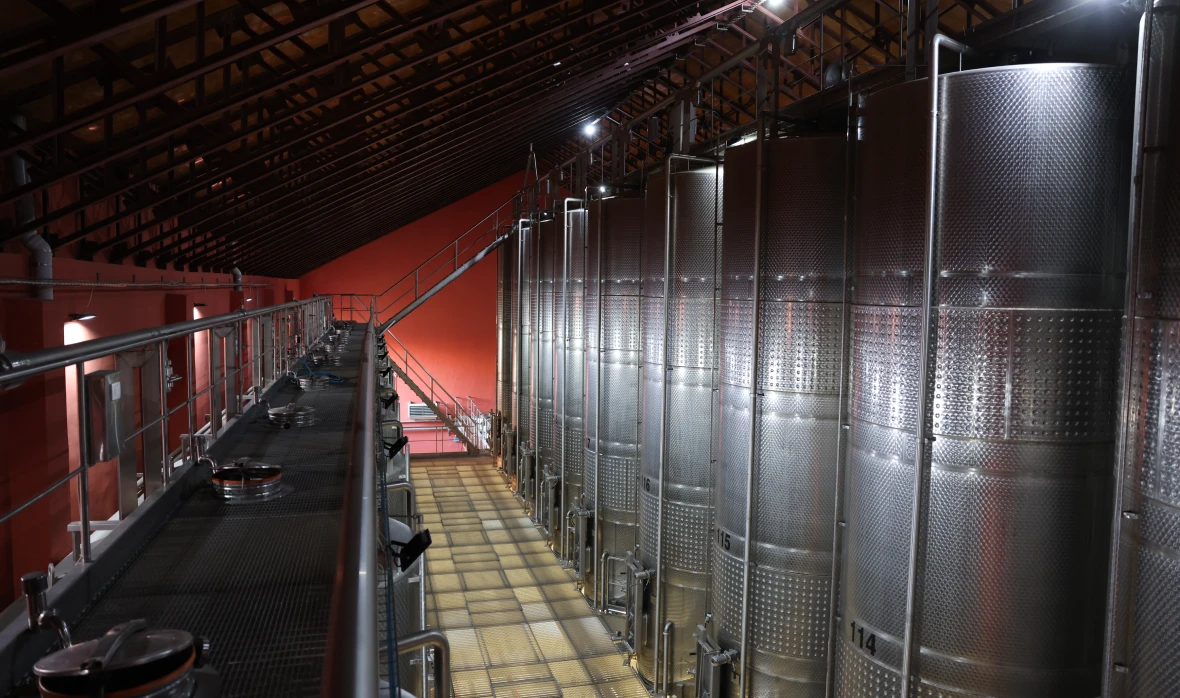Wine Production

Endless pursuit of perfection, love, and responsibility ultimately produce the best result.
PHILOSOPHY
This philosophy is the basis of our work that accompanies us in winemaking cycles. Every stage is important for us because it is the details that ensure the high quality and incomparable taste of the wine. The entire process of harvesting is done by hand. It begins in August with grapes intended for sparkling wines and ends in late October with Black Areni grapes. The grapes are first hand-sorted in the orchards, then undergo secondary sorting in the factory.


Delta Oscillis (Buscher Vaslin) decanter is used for decanting, which separates the grapes from the decanters by inertia. Due to this technique, the grapes do not break, do not get crushed and keep their integrity. The third stage of sorting of the grapes is carried out on oscillating tables after destemming. After careful destemming and sorting, the red grapes are put into temperature-controlled containers for fermentation, while the white grapes are put into a pneumatic press, which allows pressing in a controlled atmosphere and separating the grape juice from the skin and pips. The innovative controlled atmosphere pressing process guarantees 100% oxidation-free grape juice.




Delta Oscillis (Buscher Vaslin) decanter is used for decanting, which separates the grapes from the decanters by inertia. Due to this technique, the grapes do not break, do not get crushed and keep their integrity. The third stage of sorting of the grapes is carried out on oscillating tables after destemming. After careful destemming and sorting, the red grapes are put into temperature-controlled containers for fermentation, while the white grapes are put into a pneumatic press, which allows pressing in a controlled atmosphere and separating the grape juice from the skin and pips. The innovative controlled atmosphere pressing process guarantees 100% oxidation-free grape juice.
Depending on the variety and origin, the grapes are turned into wine individually, leaving the creative process of pairing to the winemaker. Malolactic fermentation takes place in stainless steel tanks or, in some cases, barrels. The cellar and storage tanks are designed with gravity in mind to reduce the effect of pumps on the wine during gravity separation.
Still wine
White wine After destemming, to lower the temperature of the grapes, the fruit, along with the juice and seeds, is transferred to a tubular heat exchanger using a pump. The harvest is then immediately sent to the membrane press. Thanks to the special regulation of the press, the pressing process is carried out in the presence of inert nitrogen gas. This regulation allows the pressing to be carried out in a controlled atmosphere and the grape juice to be separated from the skin and the stone. The innovative process of pressing in a controlled atmosphere 100% guarantees the production of grape juice without oxidation. The produced grape juice, when ripe, is transferred to stainless steel fermentation tanks, where the temperature is automatically regulated. The fermentation of white wines lasts an average of 10 days. After fermentation, the sediment is separated, and the finished wine is transferred to another tank. After undergoing appropriate processing (fining, cold treatment, filtration, laboratory control), the wine is bottled. Red wine After careful destemming and sorting, the red grapes are immediately transferred by a pump to fermentation tanks (vinifiers), where the temperature is automatically regulated. Fermentation lasts about 10 days. Depending on the grape variety and the requirements of the final wine, the winemaker determines the maceration period (10-30 days). All these processes are followed by malolactic fermentation of red wines, which also takes place in stainless steel tanks or, in some cases, in barrels. Subsequently, after undergoing appropriate processing (fining, cold treatment, filtration, laboratory control), the wine is bottled.

Sparkling wine
CHARMAT METHOD
Primary fermentation is carried out by the classical fermentation method of white wines, after which the wine is transferred to pressure-resistant containers - agrataphors (autoclave) for secondary fermentation. It is at this stage that the bubbles characteristic of sparkling wine appear. A mixture of natural yeast and sugar is already added to agrataphors for secondary fermentation. Because the vessel is airtight, the CO2 produced during secondary fermentation cannot escape and remains in the wine.
TRADITIONAL METHOD
As the largest wine company, in 2022 we made a decision to start producing sparkling wine in the French Anad way as well. Unlike the Sharma method, sparkling wines made using the traditional method undergo secondary fermentation in the bottle itself. This complex and lengthy process remains unsurpassed for centuries. Primary fermentation takes place at the lowest possible temperature to preserve the flavor characteristics of the crop. Secondary fermentation in the bottle lasts 40 days. The sparkling wine is then aged for 14+ months in the bottle. meanwhile, the bottles are rotated 45 degrees every day, which activates the separation of aromas from the sediment, and the sparkling wine is enriched with fresh brioche and floral aromas. After this process, the temporary cork is removed using a special cooling method, and the sediment is simultaneously released. The bottle is then finally labeled.